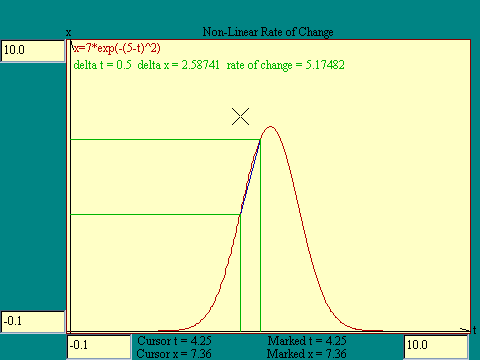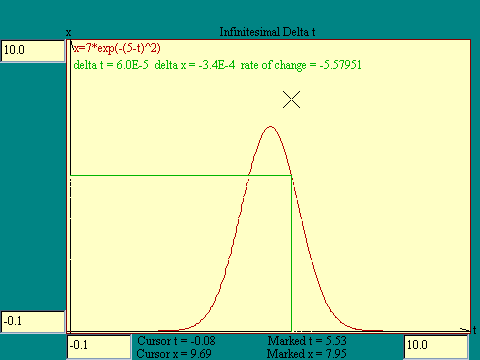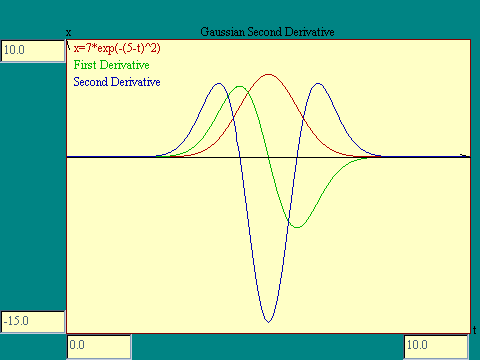|
|
|
|
Still... It does move!
|
So far in this course we have dealt in functions, mathematical
generalities without necessarily any ties to physical reality. We
illustrated that even simple functions totally deterministic,
that is without any uncertainty or randomness, may yield
information so complex as to appear chaotic. In the real world,
systems can never be precisely described in mathematical terms as
clean as those simple functions we have been working with. The
equations applying to these real systems have parameters which
are knowable only with limited precision.
The relationship of the messy real world to the tidy
mathematics used to describe it has been the subject of
considerable study over the years. When experiments produced
erratic or unexpected results it was commonly assumed that the
uncertainty or "noise" in the data fed into the
functions was at fault. It now appears that perfectly
uncontaminated data might also lead to some of the results which
in the past have been rejected as bogus. In this program we will
begin to explore real world systems some of which exhibit the
untidy behavior which I was talking about.
|

|

|
In this program we will be talking about "dynamical
systems". That concept requires a bit of discussion. Much of
what science, and engineering for that matter, tries to do is to
analyze things in motion so as to predict what will happen to
them. The things may be as large as galaxies or as small as
sub-nuclear particles. If a thing, or a collection of things is
changing somehow as time passes, it may be considered a dynamical
system. If not, it is not of interest to us. Whether or not a
thing changes with time depends on how you look at it.
The ledges that I see down at the cove have not noticeably
moved in the years I have been observing them. They are a failure as a
dynamical system on the scale of space and time I am using. The
only prediction that I can make about their future behavior is the
trivial one that tomorrow they will be pretty much the same as today.
If I change the scale in space or time on which I
observe this rock it might become a dynamical system worth
studying. This notion that the nature of a thing depends on the
scale of observation is something to keep in mind.
I know that on a molecular or atomic scale there are lots of
interesting things happening to apparently inert objects. Not
only the spatial or size scale is important but also the time
scale.
|
|
The constellation Ursa Major, or Big Dipper, has also not
changed appreciably in the years I have been watching it. Still I
know that on a much longer time scale it is a dynamical system of
great interest. We study dynamical systems to understand the
evolution of the system as time passes. This comes back to the
fundamental task of science which is to predict the future.
The most commonsense definition of a dynamical system is that
it is stuff in motion. In studying a dynamical system, those
aspects of it which do not effect its evolution in time are
generally disregarded. The color of a swinging pendulum for
example is not pertinent in describing its future position or
velocity. Those variables that are important to the development
of the system over time we will call "state variables",
and the instantaneous values of that set of variables we will say
defines the "state" of the system at that instant.
|

|

|
One of the key concepts in dynamical systems is that of the
"rate of change" of various variables. Let's spend
a few minutes reviewing that concept.
The example that most of us were first exposed to was speed
being the rate of change of distance. My first science course,
and probably yours as well, contained the formula: speed=distance/time.
This is the prototype of all rate of change formulae. In
general a rate of change may be the change in anything divided by
the corresponding change in a related variable. The slope of a
graph of x vs. t for example is the change in x divided by the
corresponding change in t. It is called the rate of change in x
with respect to t.
Since t is the independent variable, we will pick two points
on the t axis to be the interval over which we will calculate the
rate of change. The difference between these t values is called
"delta t". Customarily we subtract the lower t value
from the higher. For each of the chosen t values there will be a
corresponding value of x. We get delta x by subtracting the x
corresponding with the lower t value from that corresponding to
the upper t value. The ratio delta x over delta t is the rate of
change, and for a straight line, the slope of that line.
If the graph of x as a function of t is not a straight line,
we can still define a rate of change by taking smaller and
smaller delta t letting delta t approach zero. Then the value
which the ratio, delta x over delta t, approaches is the rate of
change of the function at the point on the t axis about which
delta t is shrinking. In this way, as long as x is a continuous
function of t, with no gaps or step changes in the graph, the
rate of change concept still makes sense. Run the
rate of change
display.
|
|
Most physical systems appear to undergo continuous changes as
time passes. Consider a ball tossed vertically upward. We do not see it
lurch from one height to another until it reaches a peak and
then tumble back in a series of steps. The motion appears smooth
and continuous when we look at it continuously. The mathematics
of continuous motion involves the rate of change as we just
described it, the limiting value of the ratio delta x over delta
t as delta t approaches zero. This limiting value has been given
the name the "derivative" of x with respect to t.
Run the
infinitesimal delta t
display.
Functions that deal in derivatives are called
"differential equations". Motion like the ball tossed
in the air may be described by differential equations. Rather
than concern ourselves with the writing and solution of
differential equations, let us consider the motion of the tossed
ball in a different way. How does the ball know what path to
follow? What determines its position at any instant? One way to
look at these questions is to claim that the initial position and
velocity of the ball determines its future trajectory, based on
the rate of change of position with respect to time.
|

|

|
The study of dynamical systems has led to the discovery of
certain laws of nature which we apply to the current state of a
system to predict a future state. Or we may take the current
state of a system and apply the laws of nature to determine what
its state was at any time in the past. These laws of nature are
really approximations which were developed to fit the
experimental evidence. These approximations are good enough to allow
us to place satellites in orbit or build the computer on which this
image is displayed. The laws relate the state variables to one another and to
time, expressed as differential equations which
require the application of calculus, experience and luck to
solve.
The solution to differential equations are functions. It is
not our purpose here to set up and solve the differential
equations for interesting systems. In fact only for certain
restricted cases are the differential equations which apply to a
dynamical system solvable at all. That is where the luck we cited
above comes into play. What we will do is look at dynamical
systems in a more qualitative way, to see what we can learn
without the high-powered mathematics.
|
|
Probably the most common way to describe the evolution of a
system with time is to express each of its state variables as a
function of time. In general we arrive at these functions by
looking at the laws (differential equations) which apply to the
system. Some systems are so simple that we can arrive at the
functions relating the state variables to time in a
straightforward manner. Then we can plug in a future time and
solve for the variable or perhaps plot a graph of the variable
versus time. For most systems though, the analytical solution is
too difficult. In program we will use a technique called
mathematical modeling.
The heart of "mathematical modeling" as carried out
by computer is this. Suppose we know that some variable, x,
depends on time, t. And we know the rate of change of x with
respect to t. To find the value of x at any t, we start with a
set of known initial conditions (x0,t0) and add to x0, the change
in x corresponding to a tiny change in t. That change in x will
just be the rate of change of x with respect to t times the
change in t. This gives us a new x. Then we repeat the process
using the recently calculated x as a new starting point. As long
as we choose the change in t to be small enough, we can go step
after step like this to any value of t we wish and find the
corresponding value of x.
|

|

|
The thing that makes mathematical modeling a practical way to
find future states of a system is the computer. The classical
solution to differential equations involved a technique called
integration, which replaced millions of trivial calculations with
a few complex ones. Before computers this was an essential tool,
otherwise we never would have been able to invent computers. Now
that the computer is available, mathematical modeling goes back
to basics, replacing a few complex calculations with millions of
trivial ones. What computers do best is simple math very
fast.
Because modeling involves finite differences in variables like
time, position or velocity, in effect the model replaces curves
with straight-line segments. By taking a very small interval, the
error caused by this substitution can be made small also. In
principle we can reduce the error to less than any requirement we
might make. In practice however as delta t gets smaller, the
number of calculations per unit of model time increases and the
time for the program to run stretches out. Whatever delta t we
select, that will be the smallest increment of time in the model.
By analogy with the photon which is the least amount of light
possible, I will call the least amount of time possible a
"chronon".
We will begin in the next section with a simple dynamical
system which everyone is probably familiar with, a pendulum.

Are there any questions?
|

 Next
Next
 Previous
Previous
 Other
Other
|
|
|
|




